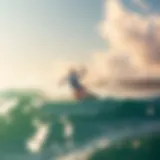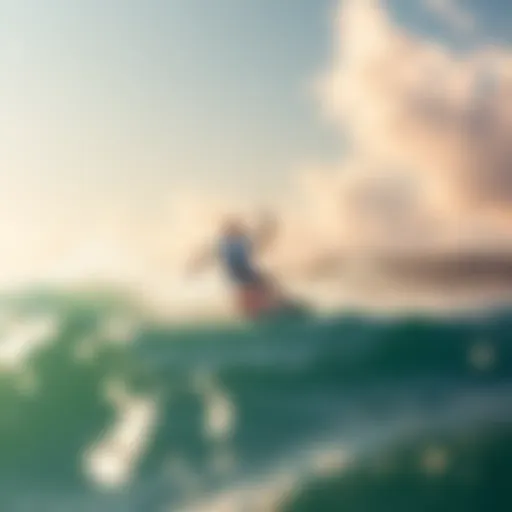Exploring the Dynamics of Windsurfing and Kitesurfing
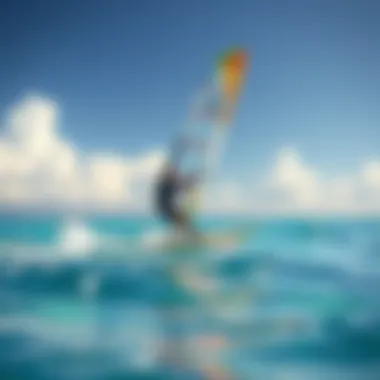
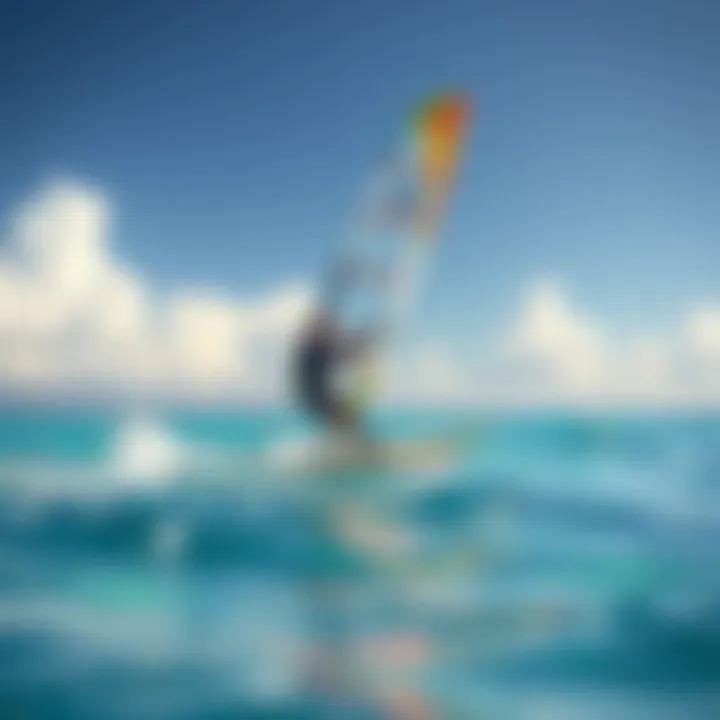
Intro
Windsurfing and kitesurfing, while often lumped together as similar water sports, possess unique characteristics that set them apart. Both activities harness the power of the wind, but the ways in which participants engage with that force create distinct experiences. This article aims to explore these fascinating sports in-depth, covering everything from equipment essentials to techniques, and safety practices. Whether you're dipping your toes into the world of wind power for the first time, or you’re an experienced rider looking to hone your skills, the insights shared here will resonate across the spectrum of interests.
Gear and Equipment
Essential Kiteboarding Gear for Beginners
When starting with kitesurfing, having the right gear is paramount. Below are some fundamental pieces of equipment that newbies must consider:
- Kite: This is your main source of power. Different types of kites exist, but beginners often opt for a simple inflatable kite that’s forgiving and easy to control.
- Bar and Lines: Controls your kite’s direction and power. A standard setup usually includes a bar with safety features.
- Harness: This connects you to the bar. It should fit snugly and comfortably, allowing you to ride for longer without fatigue.
- Board: Beginners can start with a larger board for stability before progressing to smaller ones as their skills improve.
- Safety Equipment: Always wear a helmet and impact vest. Safety should never take a back seat, especially in the beginning.
In the realm of windsurfing, essential equipment also includes:
- Sail: Usually made of durable material, choose a sail size that matches your body weight and wind conditions.
- Board: It varies significantly in shape and size, suited for different styles and skill levels.
- Mast: The mast supports the sail; a lightweight, high-quality mast can make all the difference in performance.
Advanced Equipment for Experienced Riders
As riders progress, the complexity and sophistication of their gear often evolve:
- High-Performance Kites: Advanced kites allow for better control and speed, adapting to aggressive maneuvers or waves.
- Carbon Fiber Boards: These are lighter and more responsive, providing an edge in performance when you're ready to push your limits.
- Wetsuits and Accessories: Specialized wetsuits cater to specific water temperatures and conditions, while booties or shoes can enhance grip and protection against marine life.
- GPS Devices: For tech-savvy riders, these gadgets track speed, distance, and performance, allowing analysis post-session.
Techniques and Tips
Safety Practices for Kiteboarding
Safety is a top priority in both windsurfing and kitesurfing. Here are some strategies:
- Understand Wind Patterns: Before hitting the water, grasp how wind effects vary by location. This knowledge is crucial to avoid dangerous conditions such as sudden gusts.
- Know the Right of Way: Familiarize yourself with community guidelines regarding right of way. This reduces the chance of collisions or accidents in busy areas.
- Regular Equipment Checks: Before each use, inspect kites, lines, and harnesses for wear and tear. A torn line or faulty strap can turn a fun day into a scary one very quickly.
"Failure to prepare is preparing to fail." It's crucial to ensure both your gear and skills are top-notch before venturing out.
Training Techniques to Improve Your Skills
Improving one’s skills takes time, patience, and practice. Here are a few methods:
- Take Lessons: Professional instruction can drastically speed up your learning curve. Look for certified instructors in your area. Online platforms like reddit.com can connect you with local enthusiasts and schools.
- Join Local Clubs: Engaging with community can provide support, motivation, and a wealth of experience shared by other riders.
- Practice Regularly: Consistency is key. Focus on specific techniques during each session, whether that’s jumping or refining your turns.
- Film Yourself: Use a camera to record your sessions. It's an effective method to analyze your performance and spot areas for improvement.
In summary, embarking on the journeys of windsurfing and kitesurfing involves a blend of the right gear, training, and unwavering attention to safety. Whether you're a novice or a veteran, continuous learning and adaptation are essential components of these exhilarating pursuits.
For more information on windsurfing history and gear, visit Britannica. For techniques and community support, check out Facebook groups dedicated to kitesurfing.
Intro to Windsurfing and Kitesurfing
When delving into the thrilling realms of water sports, windsurfing and kitesurfing emerge as two of the most captivating disciplines. Both sports harness the power of wind yet do so in strikingly different manners, offering unique experiences and challenges. In exploring these dynamics, one can appreciate not just the physicality and skill involved but also the communities and cultures that envelop these sports. Understanding these aspects is essential for enthusiasts, novices, and veterans alike, serving as a gateway to deeper engagement with nature and personal growth.
Definition and Overview
Windsurfing combines elements of both surfing and sailing. An athlete balances on a board while controlling a sail attached to a mast, navigating across water surfaces with agility. The key here is mastering the connection between the sail and the wind while maintaining stability on the board. On the other hand, kitesurfing leverages a large kite to pull the rider across the water, providing an aerial experience that allows for remarkable jumps and tricks. Each sport not only attracts a dedicated following but also encapsulates various styles and techniques, which can be tailored to individual preferences and skill levels.
Both activities emphasize balance, strength, and mental acuity. Practitioners often describe the invigorating sensation of catching the wind and feeling free—there’s a feeling of oneness with the environment that’s hard to replicate in other sports.
In a nutshell, windsurfing and kitesurfing cater to a diverse group of individuals, allowing them to enjoy personal achievement while connecting with like-minded adventurers.
Historical Background
The origins of windsurfing trace back to the late 1960s, where it first captivated enthusiasts in the United States. An inventor named Jim Drake teamed up with a designer, Hoyle Schweitzer, to create the first production windsurfer. This innovation changed water sports forever, as it combined the freedom of surfing with the propulsion of sailing. By the 1970s, the sport gained immense popularity, leading to various competitions and gatherings that solidified its place in the water sports arena.
Kitesurfing, however, has a more complex history. While its modern incarnation blossomed in the late 1990s, the concept of using kites for traction goes back centuries. The sport draws influences from various cultures that have played with sail-like structures. It was only when innovations in kite design and materials occurred that kitesurfing reached its current form. Despite these differences in development, both sports share a spontaneous nature, holding true to the spirit of adventure.
In summary, both windsurfing and kitesurfing are steeped in rich history, with roots reflecting innovation and a love for the water. As they have evolved over time, they have not only become sports but also lifestyle choices embraced by a vibrant and passionate community.
Equipment Essentials
When it comes to excelling in windsurfing or kitesurfing, having the right gear is absolutely essential. It's not just about looking the part on the water; the equipment is a crucial component that can significantly affect performance and safety. Different pieces of gear work harmoniously together and ensuring that you have the correct setups can mean the difference between a thrilling ride and a troublesome day out on the waves. Let's dive deep into the major components that define the experience of these exhilarating sports.
Windsurfing Gear
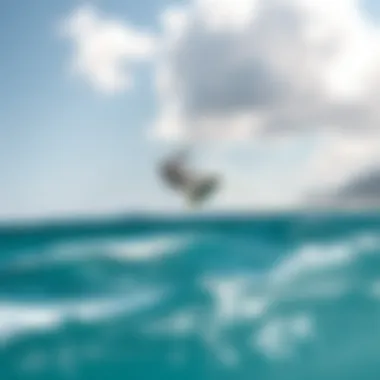
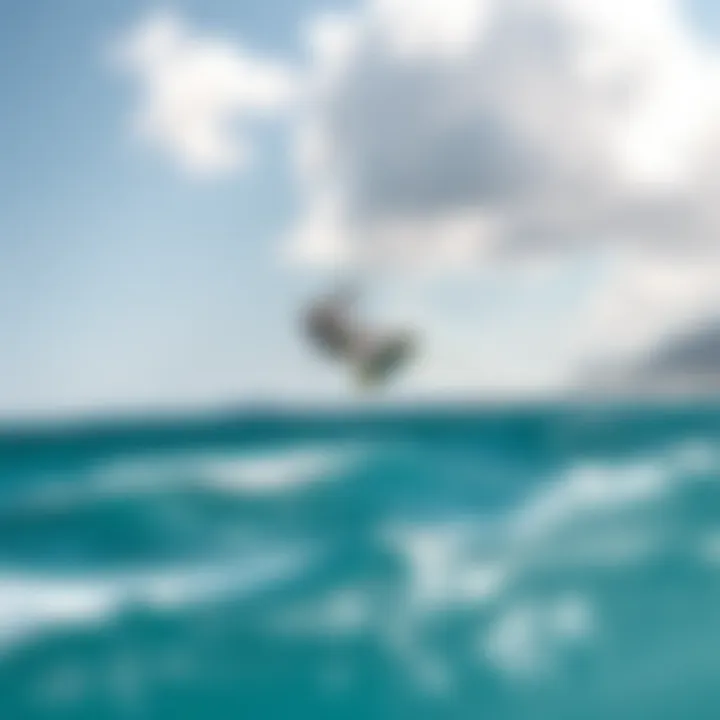
Sails
Sails are the lifeblood of windsurfing, converting wind energy into propulsion. One key characteristic of sails is their surface area, which directly influences speed and stability. Larger sails capture more wind, making them a favored choice in lighter winds, while smaller sails are beneficial in stronger gusts, providing better control. The unique feature of adjustable cams in some sails allows for fine-tuning the shape based on conditions, although they can be a hassle for beginners. This customization makes sails versatile but may also complicate things for those just starting out.
Boards
Windsurfing boards come in various shapes and sizes, tailored for different styles and conditions. A common type is the freestyle board, which is lighter and more maneuverable, helping riders perform impressive tricks. An important aspect to consider is the volume of the board—higher volume boards are easier to float, which is advantageous for beginners. However, as riders improve their skills, they may opt for lower volume boards for speed and agility, even though they can be more challenging to handle.
Masts
Masts are integral to the windsurfing setup, acting as the backbone that supports the sail. A standout feature is the material—carbon masts are lightweight and offer better performance but often come with a higher price tag. In contrast, fiberglass masts are more durable and affordable, although they tend to be heavier. Proper selection of mast length is key; incorrect sizing can hinder maneuverability, displaying how critical it is to get this aspect right.
Foils
Foils have recently taken windsurfing by storm, allowing boards to lift above the water, reducing drag significantly. The advantage of foils lies in their ability to maintain speed even in light winds, which opens a world of possible conditions for windsurfers. However, they may introduce a learning curve—controlling a foil requires a nuanced understanding of balance and pressure, which can be daunting for newcomers. This duality of opportunity and challenge makes foils both exciting and complex.
Kitesurfing Gear
Kites
Kites are the primary driving force of kitesurfing, harnessing wind power to propel riders across the water. The most critical feature lies in their design; each kite type caters to specific wind conditions. For instance, delta kites are universally loved for their stability, making them easier for beginners to fly. The trade-off here is that they may not perform as well in extreme conditions. Kites' sizes vary as well—the larger the kite, the more lift it provides in low winds, but it can become unwieldy when gusts pick up.
Boards
Kitesurfing boards differ significantly in shape compared to windsurfing boards, with a focus on versatility and maneuverability. Typically, twin-tip boards are popular due to their bidirectional design, allowing for easy direction changes. While most boards are lightweight and buoyant, some come with foot straps that enhance control when performing jumps. However, straps can limit one’s ability to bail out in emergencies, posing a safety consideration worth noting.
Harnesses
Harnesses are essential in kitesurfing, providing a secure connection between the rider and the kite. A favored characteristic of harnesses is their comfort, with padded options available for longer sessions. The unique feature of a seat harness, as opposed to a waist harness, is that it redistributes pressure across the body, which can alleviate strain on the lower back. However, it may restrict movement more than a waist harness, which enhances freedom but could lead to discomfort during long rides.
Control Bars
Control bars are the main interface between the rider and the kite, enabling manipulation of power and direction. The significant aspect of these bars is the safety systems incorporated into them; most feature quick-release mechanisms for emergencies. A negative of many control bars is that when wet, they can become slippery, leading to potential loss of grip during intense moments. Choosing the right length and configuration is vital for ensuring responsiveness and comfort during rides.
Comparative Analysis of Equipment
When comparing the gear from windsurfing and kitesurfing, it becomes clear that each sport has its own set of requirements and advantages. Windsurfing gear tends to emphasize propulsion through the board's design and the sail's efficiency, while kitesurfing focuses more on the kite's power and the rider's agility.
In essence, understanding the equipment essentials not only elucidates the intricacies of each sport but also empowers riders to make informed choices that can enhance their experience on the water. Balancing performance with safety, while considering personal skill levels and preferences, is a delicate dance that every kitesurfer and windsurfer must master.
Techniques and Skills
The art of windsurfing and kitesurfing doesn’t just live on the surface of the water; it dives deep into a skillful interplay between technique and the ever-changing environment of wind and waves. For beginners standing awkwardly on their boards or seasoned riders mastering acrobatics above the surf, the mastery of techniques forms the backbone of these sports. It’s akin to learning a new language; while one can be thrown into conversation, it’s only with practice and precision that fluency is achieved.
Understanding the nuances of techniques and skills can enhance not just performance but overall enjoyment and safety during these exhilarating activities. When mastered, key maneuvers can transform the ride from routine to downright euphoric.
Basic Maneuvers in Windsurfing
Each windsurfer starts their journey with fundamental maneuvers, which serve as the building blocks for more advanced skills. Let's take a closer look at some of the crucial ones:
Launching and Landing
Launching and landing are the first hurdles every windsurfer must clear. Launching is essential since it sets the stage for the ride. A smooth launch ensures that riders can catch the wind right off the bat, getting onto the water without much fuss. It can feel daunting at first, especially when facing waves and wind.
The key characteristic here is the gentle yet purposeful application of pressure against the mast base, which facilitates an upright position when the wind hits. The advantage of a well-executed launch is that it can save a sizable chunk of time and energy. Conversely, flaws in this maneuver can lead to a rough start, possibly leaving one floundering in the water longer than desired. Practice makes perfect, and learning to launch efficiently can lead to more time spent riding instead of re-adjusting.
Steering and Control
Steering is the lifeblood of windsurfing, allowing riders to navigate through waves and around obstacles. This skill involves the precise coordination of hands and body positioning. Riders must understand how their movements affect the board's trajectory. The unique feature of steering lies in its necessity for agility; being able to shift weight and tilting the sail are crucial.
The advantage of mastering steering and control is clear: it allows windsurfers to tackle various water conditions while maintaining speed and stability. A downside, however, is that for many beginners, the learning curve can feel steep. Yet, successful navigation fosters a sense of accomplishment and confidence on the water.
Turning Techniques
Turning techniques elevate the experience of windsurfing, enabling riders to change direction smoothly and efficiently. Mastering turns like tacks and jibes adds to a surfer's repertoire, creating the ability to maneuver with ease. The essential aspect here is the balance between trim and body movement. This equilibrium determines whether a rider flies through the turn or gets stuck.
These techniques are beneficial as they help conserve energy during a session and enhance the capability to maintain flow with the wind. However, executing turns can be tricky, especially in challenging wind conditions, leading to frustrations if not practiced properly.


Key Techniques in Kitesurfing
Kitesurfing, while different in approach, shares some foundational techniques that are equally crucial for success. Let's explore some of them:
Water Starts
Water starts are fundamental in kitesurfing, allowing riders to get on the board independently from the water surface. This technique emphasizes the timing of kite control and board placement. A successful water start is one of the most satisfying experiences; it transforms the experience from floating to flying.
The characteristic feature includes pulling on one side of the kite to create lift while pushing the board into the water. The benefits of a smooth water start vastly increase riding time and confidence, yet improper technique can lead to a frustrating struggle with the kite jerking unpredictably.
Jumping
Jumping is often the hallmark of kitesurfing for many enthusiasts. The ability to leap from the water, defying gravity, feels exhilarating. This technique requires precise control over kite positioning and speed. Riders must know how to utilize the kite’s pull to generate lift and direction.
Jumping's allure lies in its visual appeal and thrill; however, it requires significant practice to master timing and landing. Success can lead to incredible feelings of freedom, while failure may lead to awkward tumbles.
Tricks and Stunts
For those who seek to elevate their kitesurfing game, tricks and stunts become an avenue of expression. Whether they are flips, spins, or other creative maneuvers, these techniques showcase both skill and creativity. Tricks demand an understanding of kite dynamics and timing, as the rider must manipulate the kite to execute their desired move.
These elements foster a sense of creativity and individuality in riders, but they also come with risks. Not mastering the foundational techniques could lead to falls or injuries if stunts are attempted prematurely.
Advanced Skills Development
For those willing to put in the effort, advanced skills development opens new horizons in windsurfing and kitesurfing. Beyond just executing maneuvers, this phase involves fine-tuning skills to adapt to varying wind conditions and personal style. Advanced techniques include soaring jumps, complex turns, and even competitive tricks that display agility and finesse. The development of these skills often leads to more rewarding experiences, fostering a deeper connection to the sport and its community.
Key to successful advanced development is practicing in varying environments and receiving feedback from experienced instructors. With commitment and resolve, the advanced realm can lead to significant personal growth and thrill on the water.
Safety Considerations
Safety in water sports like windsurfing and kitesurfing is paramount. Engaging in these exhilarating activities without proper precautions can lead to accidents or injuries. Therefore, understanding the specific safety considerations is necessary for enjoyment and peace of mind. Being prepared not only ensures your safety but also enhances your overall experience on the water.
Safety Gear Recommendations
Impact Vests
An impact vest may not seem as fancy as other gear; however, it plays an essential role in your safety while windsurfing or kitesurfing. These vests are designed to absorb shock, which can occur during falls. When riders inadvertently take a dive, the vest helps cushion against potential injuries. A key characteristic of impact vests is their lightweight design. This feature makes them easy to wear without feeling overly bulky.
One unique quality is that they often come with buoyancy features that support floating, helping maintain your safety further in the water. However, do note that while these vests add layers of protection, they are not a substitute for life jackets. They work best in tandem with other safety gear.
Helmets
A helmet may not be the first thing that comes to mind when visualizing windsurfing, but it's undeniably a smart choice. If you’re going to hit the waves, you should protect your noggin from errant boards or unexpected falls. The main strength of helmets lies in their ability to protect against impact. That’s the game-changer when you are speeding across the water, where the wind can throw you off balance at any moment.
Good helmets are light and often come with adjustable straps for a snug fit. They can also be designed with ventilation features, ensuring you’re cool under pressure. On the downside, some helmets can feel a bit constrictive, especially if you're not used to wearing one. Finding the right size and fit is key; a loose helmet won’t aid in protection at all.
Leashes
If you want to keep your gear close during your wild rides, leashes are what you need. A leash connects your board to your body, ensuring that when you fall, you're not chasing your gear across the water. This safety measure is vital for avoiding accidents that could happen from returning to loose boards floating around.
The key characteristic here is the elasticity of the leash. A good leash is stretchy enough to allow some freedom while remaining resilient enough to withstand heavy pulls when you're flying through the air or the water. Leashes designed for kitesurfing typically include a quick-release mechanism, so if things go south, you can detach yourself quickly. But be aware; relying too heavily on a leash can lead some riders to be less mindful of their surroundings.
Understanding Environmental Factors
Wind Conditions
Wind conditions can make or break your day on the water. Understanding the wind is essential in predicting your performance and safety. Good conditions allow you to harness the power of nature; too strong or too weak can lead to trouble.
A significant advantage of knowing these conditions is that it helps you pick the right gear for the day. Each wind strength correlates with different equipment setups, helping you optimize your performance and ensure your safety. Still, riding in unpredictable winds can lead to surprises; in these cases, if you’re unsure, it's always wise to consult local forecasts or experienced sailors.
Water Hazards
When it comes to enjoying windsurfing or kitesurfing, awareness of water hazards is a necessity. These may include rocks, coral reefs, or even other boats that can bring a surfing session to a grinding halt.
Understanding the environment improves your enjoyment and minimizes risks. Riders must always be alert and know locations of these hazards, as they can be less visible or hidden under the waves. On the plus side, some spots are well-kept and documented with safety guidelines. However, venturing into new places can require extra caution as not every site has the same level of safety signage.
Weather Awareness
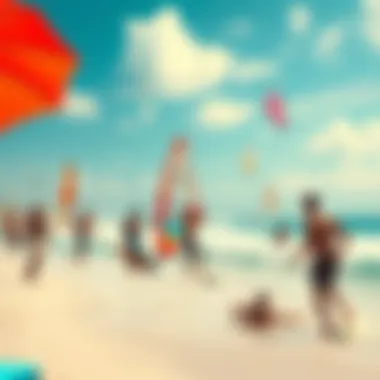
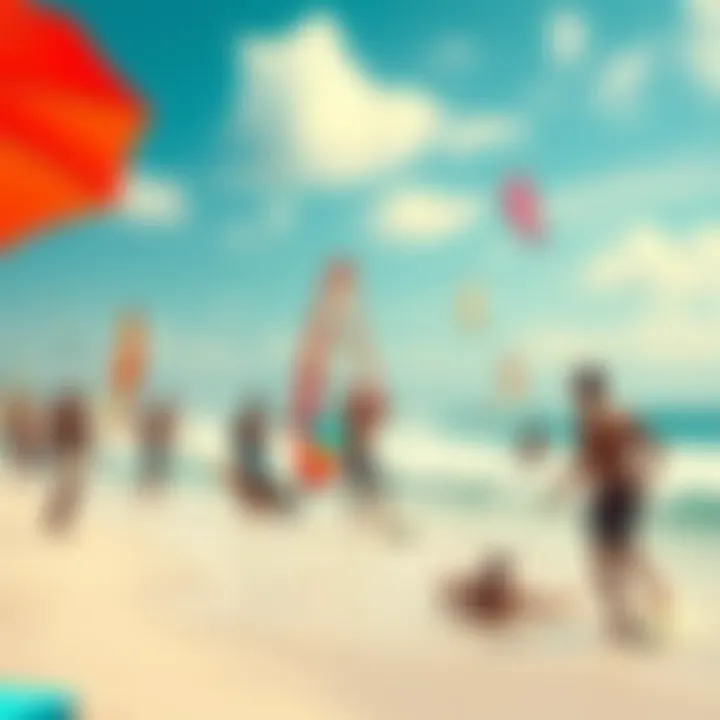
Keeping tabs on weather changes is crucial when you’re out on the water. Windsurfers and kitesurfers must understand not only current conditions but also how weather can shift unexpectedly. Sudden storms or gusty winds may appear on the horizon, turning a pleasant day into a chaotic affair.
The advantage of being weather savvy means you can plan your outings better. Those who monitor forecasts before heading out typically enjoy safer outings and can tailor their sessions for optimal conditions. But remember, electronic devices are not always reliable on the water. It’s advisable to familiarize yourself with local weather patterns and not just rely on apps or gadgets.
Always prioritize safety gear and environmental factors for a smoother, more enjoyable experience on the water.
Cultural and Community Aspects
Understanding the cultural and community aspects of windsurfing and kitesurfing is vital to grasping how these sports transcend mere physical activity. They foster a sense of belonging among participants, often resulting in diverse and vibrant communities around the world. This section doubles down on the unique culture that forms and thrives across beaches and lakes, where enthusiasts gather to share not only their passion for water sports but also their lives.
Global Windsurfing Communities
Windsurfing communities are as varied as the places where the sport is practiced. From the serene shores of Lake Tahoe in California to the gusty beaches of Tarifa in Spain, each locale cultivates its own social dynamics and traditions. Enthusiasts are often eager to lend a hand, whether through local workshops or organized meet-ups, which makes these communities rich in camaraderie. The common bond of enjoying the wind truly knits these folks together.
In many cases, friendships formed in these waters extend beyond the shoreline. Community events frequently include barbecues, beach clean-ups, and collaborative training sessions, creating lasting memories and networks of support. Websites and forums, such as reddit.com and local Facebook groups, have also become essential spaces for sharing tips, gear recommendations, and organizing get-togethers, strengthening the fabric of these communities.
Kitesurfing Destinations
Kitesurfing boasts iconic destinations that are famed not just for their conditions but for their vibrant local cultures. For instance, the Maldives, with its tropical waters and consistent winds, attracts kitesurfers from all corners of the globe. Each destination offers its unique flair. The winds and waves might draw you in, but it's the culture—often characterized by warm hospitality and local traditions—that keeps many returning year after year.
Traveling kitesurfers often participate in local festivals or collaborate with local schools for beginner classes, enriching the experience for everyone involved. The convergence of cultures creates a rich tapestry of ideas and experiences, making kitesurfing a global sport that thrives on shared enthusiasm. Recommendations for places to kite include the breathtaking beaches of Cabarete in the Dominican Republic and the stunning conditions found at Cape Town in South Africa.
Events and Competitions
Events and competitions play a pivotal role in shaping the community and cultural narratives of both windsurfing and kitesurfing. Competitions highlight not just individual prowess but also unity among participants, often resembling family gatherings on a grand scale. Major events such as the World Kitesurfing Championship draw competitors and spectators alike, creating a festive atmosphere.
These events also serve as a platform for promoting sustainable practices within the community, as many contest organizers advocate for protecting the beauty of natural settings.
Furthermore, such competitions are breeding grounds for innovation, as riders showcase new techniques and equipment. In essence, competitions elevate the sport into a spectacle, yet they retain the intimate feeling of a well-loved gathering among friends.
"The winds in your sails can take you places, but it’s the community that keeps you grounded."
In summary, cultural and community aspects are at the heart of windsurfing and kitesurfing, making these sports not merely pastimes but a way of experiencing and connecting with the world and each other.
Environmental Impact of Water Sports
Understanding the environmental impact of water sports like windsurfing and kitesurfing is crucial in today’s eco-conscious world. As these sports gain popularity, the pressure on waterways and coastal ecosystems increases. It’s pivotal to recognize both the benefits they can bring and the potential harm they might cause. This section will explore sustainability practices, conservation efforts, and the responsibility of the sports community in preserving our precious natural resources.
Sustainability Practices
Sustainability in windsurfing and kitesurfing encompasses a range of practices aimed at reducing ecological footprints while still enjoying the thrill of the sport. Here are some key aspects:
- Eco-friendly Materials: Many brands are now producing boards and sails from sustainable materials, such as recycled plastics or sustainably sourced woods. This shift not only reduces waste but also encourages a circular economy within the water sports industry.
- Proper Disposal: Participants should be conscious of disposing of waste responsibly. This includes properly discarding any plastic, wrappers, or personal items, especially in and around beautiful yet sensitive coastal areas.
- Local Regulations: Bound by local environmental laws, water sports participants must respect regulations that protect wildlife and habitats. This sometimes means altering one’s typical routine to avoid disturbing nesting birds or aquatic ecosystems.
Implementing these sustainable practices can help shield our waterways while still allowing enthusiasts to partake in their favorite sports. Every small action contributes to a larger collective positive impact.
Conservation Efforts
Efforts to conserve aquatic environments play a crucial role in the longevity of windsurfing and kitesurfing. Several noteworthy conservation initiatives address the needs of marine ecosystems:
- Clean-Up Campaigns: Organizations often organize grassroots clean-up events to tackle ocean debris. Taking part in these initiatives not only beautifies the natural surroundings but also raises awareness about water pollution.
- Research and Monitoring: Scientists and regulatory bodies keep a close eye on water quality and marine life health, ensuring that any negative impacts from water sports activities are assessed and minimized. Learning how certain activities affect local ecosystems can prompt necessary adjustments in practices.
Blockquote:
"Water sports provide exhilaration, yet they carry a duty of stewardship for our oceans and shores."
- Community Engagement: Leveraging local communities helps to foster a better understanding of environmental preservation. Educational programs and workshops can teach water sports enthusiasts about the delicate balance of ecosystems and how to navigate their sporting activities responsibly.
Through these conservation efforts, athletes are not only preserving the beauty of nature for future generations but also ensuring the continued enjoyment of windsurfing and kitesurfing.
Taking responsibility for environmental impacts starts with individuals but needs to be embraced by the entire community. Together, windsurfing and kitesurfing can thrive harmoniously alongside nature.
Ending
In wrapping up our exploration of windsurfing and kitesurfing, it becomes clear that both sports offer a unique blend of thrill and challenge, regardless of one's experience level. These dynamic activities not only provide an adrenaline rush but also foster a deep connection with nature, engaging both body and mind in ways that few other sports do.
Future of Windsurfing and Kitesurfing
The future for windsurfing and kitesurfing looks promising with continued advancements in technology, enhancing performance and accessibility. As aerial tricks and freestyle maneuvers gain popularity, we will likely see an influx of new enthusiasts eager to learn the ropes. Here are several key factors shaping the horizon of these exciting sports:
- Eco-Friendly Innovations: Many gear manufacturers are stepping up their game by adopting sustainable materials and practices to reduce environmental footprints. This not only appeals to environmentally conscious participants but also echoes a greater global commitment to conservation.
- Accessibility: With the rise of inflatable kites and lighter windsurfing boards, more people can hop on board with ease. This accessibility opens up opportunities for recreational athletes and weekend warriors who might have found the traditional gear daunting.
- Community Building: Online platforms, such as Reddit and Facebook groups, play a pivotal role in uniting enthusiasts. Sharing tips, offering guidance, and organizing meet-ups are common, ensuring that people's passion remains fostered.
- Safety Advancements: Ongoing education in safety practices keeps participants engaged while minimizing accidents on the water. Course offerings and safety equipment are evolving to meet the needs of adventure seekers.
"In the sport of windsurfing and kitesurfing, the only limit is the sky."
For further reading on windsurfing and kitesurfing history, techniques, and gear, consider visiting Wikipedia or engaging with communities on Reddit and Facebook.


